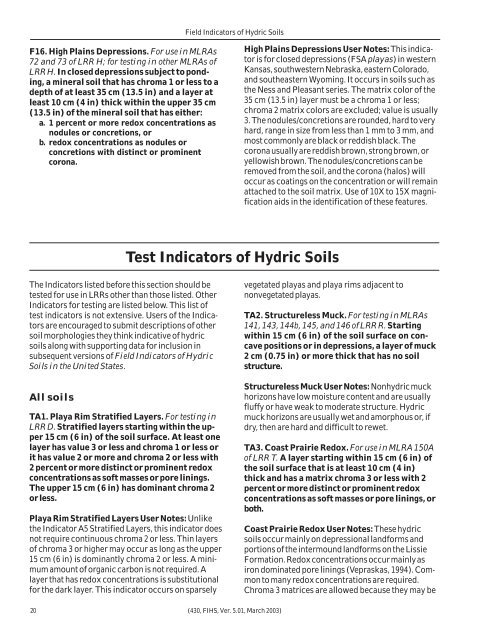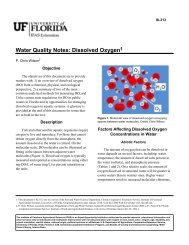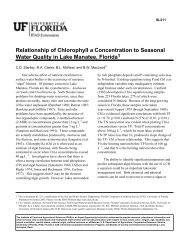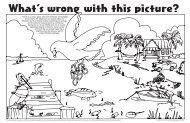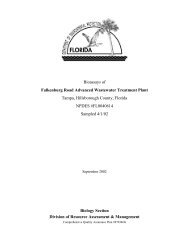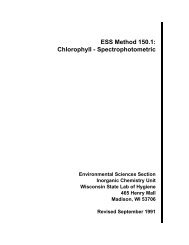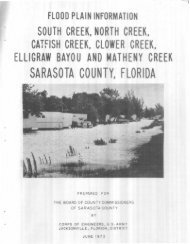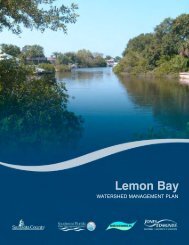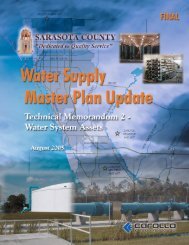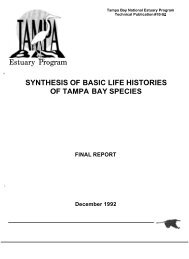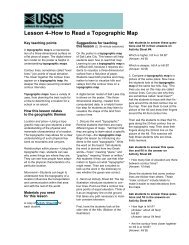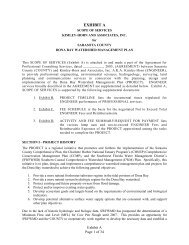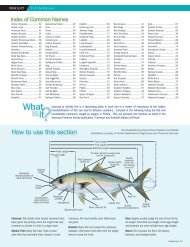Field Indicators of Hydric Soils in the United States - ITC
Field Indicators of Hydric Soils in the United States - ITC
Field Indicators of Hydric Soils in the United States - ITC
You also want an ePaper? Increase the reach of your titles
YUMPU automatically turns print PDFs into web optimized ePapers that Google loves.
<strong>Field</strong> <strong>Indicators</strong> <strong>of</strong> <strong>Hydric</strong> <strong>Soils</strong>F16. High Pla<strong>in</strong>s Depressions. For use <strong>in</strong> MLRAs72 and 73 <strong>of</strong> LRR H; for test<strong>in</strong>g <strong>in</strong> o<strong>the</strong>r MLRAs <strong>of</strong>LRR H. In closed depressions subject to pond<strong>in</strong>g,a m<strong>in</strong>eral soil that has chroma 1 or less to adepth <strong>of</strong> at least 35 cm (13.5 <strong>in</strong>) and a layer atleast 10 cm (4 <strong>in</strong>) thick with<strong>in</strong> <strong>the</strong> upper 35 cm(13.5 <strong>in</strong>) <strong>of</strong> <strong>the</strong> m<strong>in</strong>eral soil that has ei<strong>the</strong>r:a. 1 percent or more redox concentrations asnodules or concretions, orb. redox concentrations as nodules orconcretions with dist<strong>in</strong>ct or prom<strong>in</strong>entcorona.High Pla<strong>in</strong>s Depressions User Notes: This <strong>in</strong>dicatoris for closed depressions (FSA playas) <strong>in</strong> westernKansas, southwestern Nebraska, eastern Colorado,and sou<strong>the</strong>astern Wyom<strong>in</strong>g. It occurs <strong>in</strong> soils such as<strong>the</strong> Ness and Pleasant series. The matrix color <strong>of</strong> <strong>the</strong>35 cm (13.5 <strong>in</strong>) layer must be a chroma 1 or less;chroma 2 matrix colors are excluded; value is usually3. The nodules/concretions are rounded, hard to veryhard, range <strong>in</strong> size from less than 1 mm to 3 mm, andmost commonly are black or reddish black. Thecorona usually are reddish brown, strong brown, oryellowish brown. The nodules/concretions can beremoved from <strong>the</strong> soil, and <strong>the</strong> corona (halos) willoccur as coat<strong>in</strong>gs on <strong>the</strong> concentration or will rema<strong>in</strong>attached to <strong>the</strong> soil matrix. Use <strong>of</strong> 10X to 15X magnificationaids <strong>in</strong> <strong>the</strong> identification <strong>of</strong> <strong>the</strong>se features.Test <strong>Indicators</strong> <strong>of</strong> <strong>Hydric</strong> <strong>Soils</strong>The <strong>Indicators</strong> listed before this section should betested for use <strong>in</strong> LRRs o<strong>the</strong>r than those listed. O<strong>the</strong>r<strong>Indicators</strong> for test<strong>in</strong>g are listed below. This list <strong>of</strong>test <strong>in</strong>dicators is not extensive. Users <strong>of</strong> <strong>the</strong> <strong>Indicators</strong>are encouraged to submit descriptions <strong>of</strong> o<strong>the</strong>rsoil morphologies <strong>the</strong>y th<strong>in</strong>k <strong>in</strong>dicative <strong>of</strong> hydricsoils along with support<strong>in</strong>g data for <strong>in</strong>clusion <strong>in</strong>subsequent versions <strong>of</strong> <strong>Field</strong> <strong>Indicators</strong> <strong>of</strong> <strong>Hydric</strong><strong>Soils</strong> <strong>in</strong> <strong>the</strong> <strong>United</strong> <strong>States</strong>.All soilsTA1. Playa Rim Stratified Layers. For test<strong>in</strong>g <strong>in</strong>LRR D. Stratified layers start<strong>in</strong>g with<strong>in</strong> <strong>the</strong> upper15 cm (6 <strong>in</strong>) <strong>of</strong> <strong>the</strong> soil surface. At least onelayer has value 3 or less and chroma 1 or less orit has value 2 or more and chroma 2 or less with2 percent or more dist<strong>in</strong>ct or prom<strong>in</strong>ent redoxconcentrations as s<strong>of</strong>t masses or pore l<strong>in</strong><strong>in</strong>gs.The upper 15 cm (6 <strong>in</strong>) has dom<strong>in</strong>ant chroma 2or less.Playa Rim Stratified Layers User Notes: Unlike<strong>the</strong> Indicator A5 Stratified Layers, this <strong>in</strong>dicator doesnot require cont<strong>in</strong>uous chroma 2 or less. Th<strong>in</strong> layers<strong>of</strong> chroma 3 or higher may occur as long as <strong>the</strong> upper15 cm (6 <strong>in</strong>) is dom<strong>in</strong>antly chroma 2 or less. A m<strong>in</strong>imumamount <strong>of</strong> organic carbon is not required. Alayer that has redox concentrations is substitutionalfor <strong>the</strong> dark layer. This <strong>in</strong>dicator occurs on sparselyvegetated playas and playa rims adjacent tononvegetated playas.TA2. Structureless Muck. For test<strong>in</strong>g <strong>in</strong> MLRAs141, 143, 144b, 145, and 146 <strong>of</strong> LRR R. Start<strong>in</strong>gwith<strong>in</strong> 15 cm (6 <strong>in</strong>) <strong>of</strong> <strong>the</strong> soil surface on concavepositions or <strong>in</strong> depressions, a layer <strong>of</strong> muck2 cm (0.75 <strong>in</strong>) or more thick that has no soilstructure.Structureless Muck User Notes: Nonhydric muckhorizons have low moisture content and are usuallyfluffy or have weak to moderate structure. <strong>Hydric</strong>muck horizons are usually wet and amorphous or, ifdry, <strong>the</strong>n are hard and difficult to rewet.TA3. Coast Prairie Redox. For use <strong>in</strong> MLRA 150A<strong>of</strong> LRR T. A layer start<strong>in</strong>g with<strong>in</strong> 15 cm (6 <strong>in</strong>) <strong>of</strong><strong>the</strong> soil surface that is at least 10 cm (4 <strong>in</strong>)thick and has a matrix chroma 3 or less with 2percent or more dist<strong>in</strong>ct or prom<strong>in</strong>ent redoxconcentrations as s<strong>of</strong>t masses or pore l<strong>in</strong><strong>in</strong>gs, orboth.Coast Prairie Redox User Notes: These hydricsoils occur ma<strong>in</strong>ly on depressional landforms andportions <strong>of</strong> <strong>the</strong> <strong>in</strong>termound landforms on <strong>the</strong> LissieFormation. Redox concentrations occur ma<strong>in</strong>ly asiron dom<strong>in</strong>ated pore l<strong>in</strong><strong>in</strong>gs (Vepraskas, 1994). Commonto many redox concentrations are required.Chroma 3 matrices are allowed because <strong>the</strong>y may be20 (430, FIHS, Ver. 5.01, March 2003)


